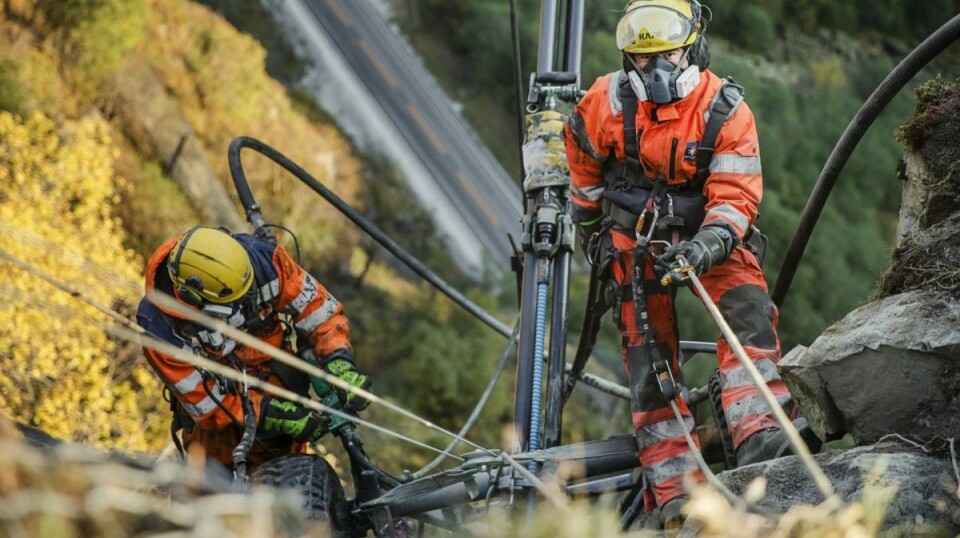THIS CONTENT IS BROUGHT TO YOU BY stami - National Institute of Occupational Health in norway- READ MORE

Why many may struggle with tying shoelaces or buttoning shirts
An unseen hazard has subtly infiltrated Norwegian workplaces: 'bad vibrations'.
There is an occupational disease that attacks the small nerves and blood vessels in the fingers over time. It is called hand-arm vibration syndrome (HAVS).
HAVS can particularly affect workers who use common tools with vibations such as handheld power tools.
The problem often goes undetected at the beginning and manifests as tingling, numbness, and circulation problems in cold weather. It can turn the fingers completely white. In some cases, the joints and muscles in the hands and arms can also be affected.
Approximately 60,000 workers in the Norwegian construction industry report being exposed to vibrations from handheld power tools for a quarter of the workday or more.
Risk of reduced functionality
“When you get injured from working with vibrating power tools, it leads to various problems, such as reduced function, pain, cold hands, white fingers, and cold intolerance," Thomas Clemm says.
He is a researcher at STAMI, the National Institute of Occupational Health in Norway. Clemm has recently completed a PhD on vibration exposure and neurological symptoms.
"This affects a person’s ability to work, but also their everyday life. Simple tasks that require finger dexterity, like buttoning up a jacket, may become difficult,” he says.
Together with colleagues at STAMI, Clemm has carried out a research project that has examined new technological solutions to reduce hand-arm vibrations.
In the project, they selected handheld power tools known to contribute to the risk of vibration injuries in the construction industry.
Modified rock drills
The researchers investigated the effects of modifying such power tools.
They worked with rock drills used to insert bolts into the rock face to prevent rocks and boulders from falling onto roads.
The researchers selected two types of rock drills and installed ATVA technology, a mechanical device that dampens vibrations by creating counter motion with the same frequency as the vibration it is designed to dampen.
They also installed spring-damping mechanisms on the handles of the rock drills. These mechanisms could easily be retrofitted on ordinary rock drills.
Then the researchers tested the tools before and after the modifications.
Significant reductions are possible
“The project shows that it is possible to reduce vibrations from the relevant power tools, in some cases by more than 75 per cent of the original vibration level. This will contribute to a lower risk of HAVS among workers,” says Clemm.
He emphasises that an important part of the project is to inform decision-makers about the possibilities offered by technical improvements to reduce the risk of HAVS.
“It's possible to incorporate measures both while constructing machines and through retrofitting damping technology. The knowledge from this project can also be transferred to other handheld and hand-operated machines," the researcher says.
Another advantage of reducing vibrations is that the equipment can be used for a longer time before reaching the intervention value.
References:
Clemm et al. Dose-response relationship between hand-arm vibration exposure and vibrotactile thresholds among roadworkers, Occupational and Environmental Medicine, vol. 77, 2020. DOI: 10.1136/oemed-2019-105926
Clemm et al. Exposure-response relationship between hand-Arm vibration exposure and vibrotactile thresholds among rock drill operators: A 4-year cohort study, Occupational and Environmental Medicine, 2022. DOI: 10.1136/oemed-2022-108293
Clemm et al. Hand-arm vibration exposure in rock drill workers. A comparison between measurements with hand-attached and tool-attached accelerometers, Annals of Work Exposures and Health, 2021. DOI: 10.1093/annweh/wxab051
Clemm, T. 'Bad vibrations: Exposure-response between rock drilling and vibration sensitivity at the fingertips', Doctoral dissertation at the University of Oslo, 2023. (About the dissertation)
More content from STAMI:
-
Technical issues at work may increase the risk of sick leave
-
This is what we now know about working from home
-
Cellular offices contribute to job control
-
More people develop allergies to common preservative in makeup and household products
-
Are some employees better equipped to defend themselves against workplace bullying than others?
-
Automation in waste sorting facilities may be more damaging to workers' health





































